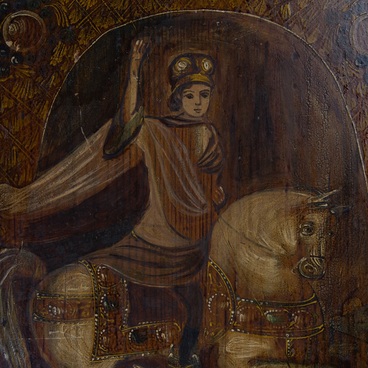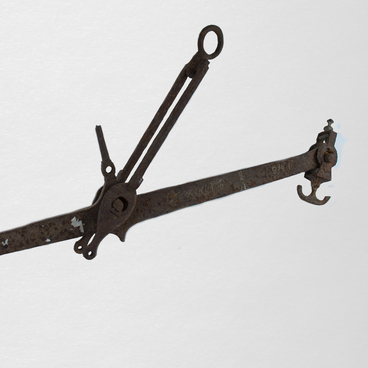The icon of Our Lady of Kazan was created by Zanarevsky, one of the Pogar icon painters, in the 19th century.
Records of the Pogar workshop of icon painters have been found since the 17th century. At various times, up to 50 masters and their students were engaged in the workshop. Pogar was located on the border territory with the Ukrainian lands located in the west, so the speech of the Pogars often contained words borrowed from the Ukrainian language. For example, the students there were called “uchny”.
Each master had from two to five uchny working for them. They were considered servants, who helped with the housework and washed clothes. The students also took part in the creation of icons by preparing brushes and rubbing up paints. These preparatory works often took much longer than the actual creation of images. Uchny were not permitted to paint the icon itself, they could only make outlines for the future icon, while faces, hands, as well as other fine artistic elements were painted by their master. To become a master, a person had to be a student for several years and then submit their works to the commission. After that, they contributed a certain amount to the workshop treasury and organized a “wine and dine” ceremony for experienced craftsmen with bread wine and snacks.
The icon painters worked in the Starodub-Seversky style. This style is characterized by a yellowish-brown background and large flowers with green leaves in the upper corners. Maxim Levdik, a philistine who was also a skilled carver, was considered one of the best Pogar icon painters at the turn of the 20th century. He created iconostases for the Trinity and St. Nicholas Churches of Pogar.
The icon of the Mother-of-God of Kazan is one of the most revered icons both in Pogar and throughout Russia. Judging by its plot, it can be attributed to the iconographic type of Hodegetria (“She Who Points the Way”). It is believed that the first image of the Hodegetria was painted by Luke the Evangelist. Such icons show the Mother-of-God with Jesus Christ in her arms. The Holy Child holds a scroll in one hand and raises the other one in a blessing gesture.
The Kazan icon differs from other variations of the Hodegetria, for the Mother-of-God is depicted half-length. The Christ Child is painted full-face to his waist, with only one hand visible — the right one with a blessing gesture.
Records of the Pogar workshop of icon painters have been found since the 17th century. At various times, up to 50 masters and their students were engaged in the workshop. Pogar was located on the border territory with the Ukrainian lands located in the west, so the speech of the Pogars often contained words borrowed from the Ukrainian language. For example, the students there were called “uchny”.
Each master had from two to five uchny working for them. They were considered servants, who helped with the housework and washed clothes. The students also took part in the creation of icons by preparing brushes and rubbing up paints. These preparatory works often took much longer than the actual creation of images. Uchny were not permitted to paint the icon itself, they could only make outlines for the future icon, while faces, hands, as well as other fine artistic elements were painted by their master. To become a master, a person had to be a student for several years and then submit their works to the commission. After that, they contributed a certain amount to the workshop treasury and organized a “wine and dine” ceremony for experienced craftsmen with bread wine and snacks.
The icon painters worked in the Starodub-Seversky style. This style is characterized by a yellowish-brown background and large flowers with green leaves in the upper corners. Maxim Levdik, a philistine who was also a skilled carver, was considered one of the best Pogar icon painters at the turn of the 20th century. He created iconostases for the Trinity and St. Nicholas Churches of Pogar.
The icon of the Mother-of-God of Kazan is one of the most revered icons both in Pogar and throughout Russia. Judging by its plot, it can be attributed to the iconographic type of Hodegetria (“She Who Points the Way”). It is believed that the first image of the Hodegetria was painted by Luke the Evangelist. Such icons show the Mother-of-God with Jesus Christ in her arms. The Holy Child holds a scroll in one hand and raises the other one in a blessing gesture.
The Kazan icon differs from other variations of the Hodegetria, for the Mother-of-God is depicted half-length. The Christ Child is painted full-face to his waist, with only one hand visible — the right one with a blessing gesture.



